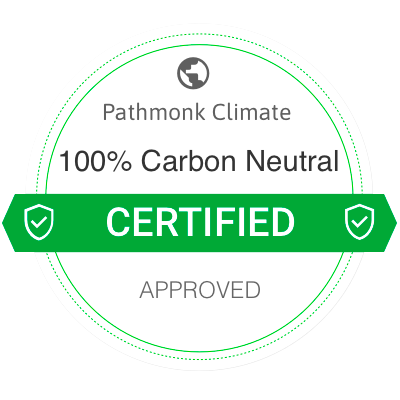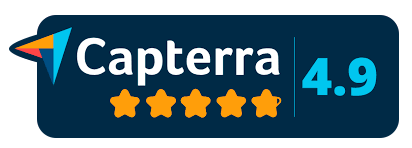
Remember when Socrates said, “I know that I know nothing”? 🤔
Ok, maybe you don’t—fair enough, it was 2,400 years ago. BUT, it’s still relevant. The awareness stage is basically your audience having their own Socrates moment. They’re just starting to figure out that they don’t know enough about a problem they’re dealing with.
At this point, they’re not looking for solutions (yet). I mean, most likely they still have no clue about what could possibly help them. They’re not comparing brands or reading product specs. They’re simply trying to make sense of things—to give a name to the challenge they’re facing and understand it better. This means your job as a marketer isn’t to push solutions or shout about your product. It’s to help them make sense of their issues.
To do that effectively and ultimately increase conversions, you need to align your marketing efforts with where they are in their journey. The customer journey is often visualized as a funnel, with different content, strategies, and campaigns working best at each stage. At the awareness stage—right at the top of the funnel (TOFU)—your focus should be on building brand awareness and offering value without asking for anything in return.
So, how do you do that? By creating content and strategies that meet them where they are: curious, cautious, and in need of answers.
Let’s break down the best approaches for nailing the tofu stage 🥢
Table of Contents
What is the awareness stage?
The awareness stage is the first phase of the buyer’s journey, where people start realizing they have a problem, need, or opportunity. As we mentioned before, they’re not ready to purchase anything—they’re focused on understanding their situation and figuring out what’s going on. It’s the phase where curiosity begins, but clarity is still missing.
Here’s a detailed breakdown of what happens in the awareness stage:
1. Recognizing a problem or need
At this point, buyers experience a trigger that makes them realize something isn’t quite right. This could be a business noticing a drop in sales or an individual feeling frustrated with outdated software. They know there’s an issue but can’t yet articulate it fully.
For example, a business might observe that their website traffic is declining but aren’t sure why, or a homeowner might notice their energy bills are unusually high without knowing the exact cause.
2. Seeking to understand the problem
Once buyers recognize a problem, their first instinct is to research and gather general information about it. They’re looking to define what’s going on and understand the scope of the issue. This stage is about asking questions like, “Why is this happening?” or “What does this mean for me?”
For instance, a business might search for “Why is my website traffic dropping?” or “How do I improve customer engagement?” They’re not exploring solutions yet—they’re trying to make sense of their situation.
3. Exploring the implications
After identifying their problem, buyers begin to understand why it matters and what’s at stake. They start exploring how this issue could impact them if it’s left unresolved. This is where they begin to prioritize addressing the problem.
Following the same example, a business might realize that declining website traffic could lead to fewer leads and lower revenue. This step builds urgency for them to move forward in their journey.
4. Consuming educational content
Buyers rely heavily on educational content during the awareness stage. They engage with blog posts, videos, infographics, and guides that help them better understand their problem. The content they consume should answer their questions, clarify the problem, and introduce industry knowledge without diving into solutions.
So, in this case, they might read an article like, “5 Reasons Your Marketing Campaign Isn’t Converting” or watch a video on “The Basics of Customer Conversion Funnels.” This content builds trust and keeps your brand in their mind as they progress.
5. Becoming aware of brands (indirectly)
While the focus isn’t on solutions yet, buyers are starting to notice the brands that provide the helpful content they’re consuming. They may not fully engage or explore your offerings, but this stage lays the groundwork for future trust. Subtle branding, such as a consistent tone or visuals, can make your business memorable without being intrusive.
So, simply put, this stage is where your business comes in to save the day. By offering the right content, you have the ability to provide a solution for this prospective customer. The client doesn’t know your business yet or how it can offer a solution. In this awareness stage, it’s your job to make these potential clients aware of your brand and the products or services you can offer them.
Free template: CRO testing framework
Organize, prioritize, and execute conversion rate optimization tests with our framework.
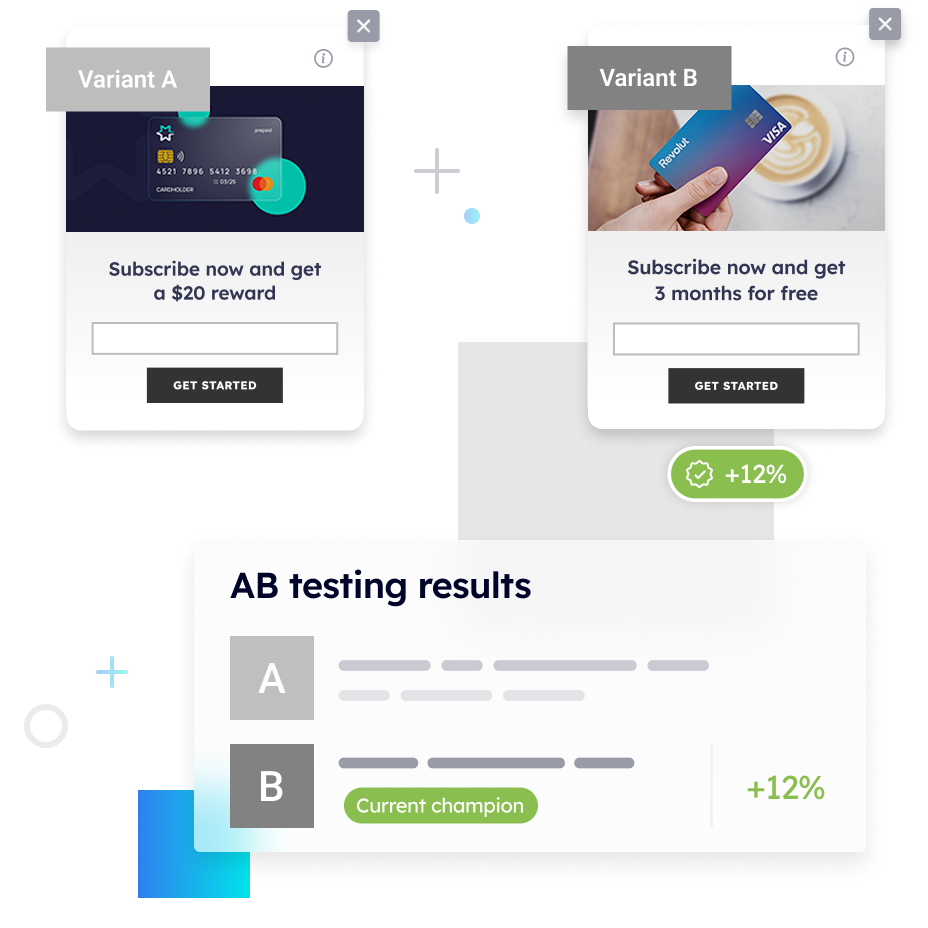
Why is the awareness stage important?
The awareness stage is where the buyer’s journey begins—it’s the critical moment when potential customers realize they have a problem or need. If your brand doesn’t effectively engage prospects during this stage, they might never progress further in their journey. The awareness stage lays the foundation for the rest of the process by helping buyers identify and understand their challenges.
How well your business provides value in the awareness stage can determine whether prospects see you as a credible resource when they’re ready to explore solutions. Brands that create educational, engaging, and trustworthy content during this phase stand out, making it more likely that buyers will remember them as they move toward the consideration stage.
In short, the awareness stage is where your relationship with potential customers starts. It’s your opportunity to spark curiosity, build trust, and guide them to the next step in their journey.
What question can help define your awareness stage?
To define the awareness stage effectively, you need to focus on how potential customers realize their problem and begin searching for answers. A key question to guide your understanding of this stage is:
“What triggers potential customers to recognize their problem and start seeking information about it?”
This question prompts you to explore several critical aspects of the awareness stage:
- What events or circumstances trigger awareness?
Are there specific pain points or challenges that make buyers realize they have an issue? For example, a business might notice declining sales or a homeowner might notice rising energy costs. - What questions do buyers ask in the awareness stage?
Are they searching for “why” something is happening? These are usually problem-focused questions like, “Why is my website traffic dropping?” or “What causes low customer engagement?” - Where do buyers go for information?
Do they rely on search engines, forums, social media, or industry blogs? Understanding their preferred sources helps you meet them where they’re already looking. - What kind of content resonates with them?
Are they consuming blog posts, videos, infographics, or guides? Knowing their content preferences allows you to create resources that feel natural and useful. - What emotions or motivations drive their search?
Are they frustrated, curious, or feeling pressured to solve a problem? Emotional drivers can shape how you craft your messaging.
By answering these questions, you can better understand how to guide buyers through the awareness stage. The goal is to position your brand as the trusted resource that helps them make sense of their challenges and prepares them for the next phase: consideration.
What are the goals of the awareness stage?
Plot twist—the real goal is to move prospects down to the next stage in your customer journey—aka the consideration stage—so they end up becoming customers.
I bet you didn’t see that one coming.
Jokes aside, and from a more user-centric perspective, the awareness stage has several key goals that should guide your approach as a marketer.
First, you have to help buyers identify and articulate their problem. At this stage, they might sense that something isn’t working but can’t fully define it. Your role is to provide educational content that helps them put a name to the challenge and better understand its impact. For example, an article titled “Why Your Website Traffic Is Dropping and What It Means” could help them recognize their issue more clearly.
Second, building trust and credibility is essential. Buyers at this stage are looking for information, not solutions, so your focus should be on creating content that informs rather than sells. By offering helpful, well-researched resources, you position yourself as a go-to authority they can rely on for guidance.
Another goal of the awareness stage is creating awareness of your brand without being too promotional. Through subtle branding in your content, such as consistent tone, visuals, and voice, you ensure your business stays memorable. The idea is to introduce your audience to your expertise while keeping the focus on them and their needs.
Engaging and capturing interest is also crucial. Educational content should be designed to answer their questions while leaving them curious to learn more. Think of this as the beginning of a relationship—your goal is to keep them coming back for additional insights and guidance.
But yes, as we said before, the ultimate purpose of the awareness stage is to encourage the next step in the buyer’s journey: consideration. By educating without overwhelming and leaving subtle hints about solutions, you gently nudge your audience toward exploring how their problem might be solved. A blog post might end with a CTA like, “Ready to take the next step? Here’s a guide to choosing the best tools to boost your marketing.”
In short, the awareness stage is about building a foundation—helping buyers understand their problem, earning their trust, and keeping them engaged so they’re ready to move forward with you when the time comes.
Increase +180%
leads
demos
sales
bookings
from your website with AI
Get more conversions from your existing website traffic delivering personalized experiences.
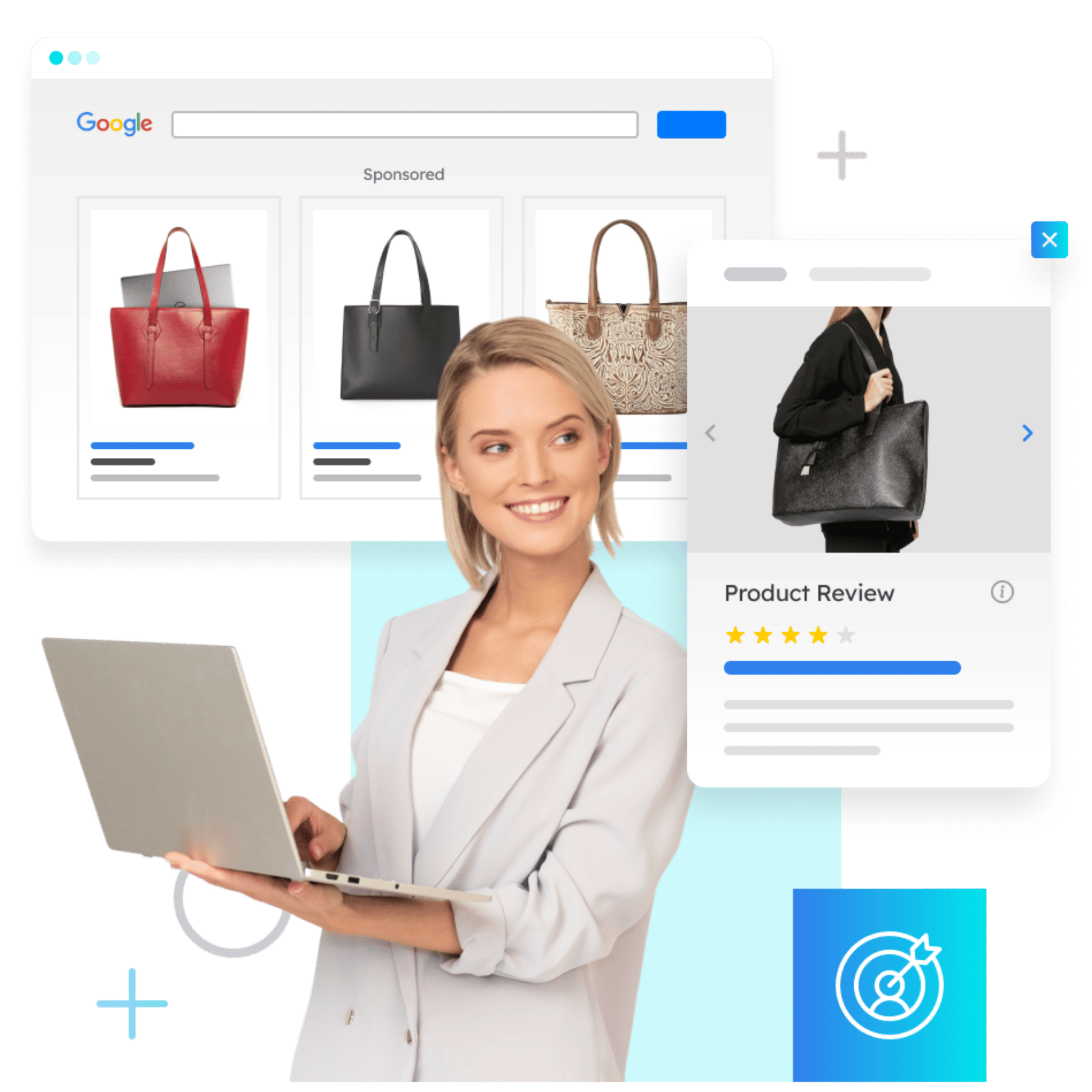
What role does the awareness stage play in the customer journey?
The awareness stage is where buyers wake up to the fact that something’s not right. It’s their “Hmm, I might have a problem here” moment. But instead of jumping to solutions, they’re in exploration mode, trying to piece together what’s actually going on.
Here’s where you step in—not as the brand shouting, “We’re the answer!” but as the one that helps them ask the right questions. The awareness stage is your chance to set the narrative, position yourself as a resource, and build enough intrigue that when they’re ready to move forward, they’re thinking about you. But how is this possible?
Well, the content created for the other stages of the buyer’s journey (consideration, decision, and closing) is irrelevant if there aren’t any leads that are made aware of your business and its products or services. The awareness stage can be seen as the foundation of the buyer’s journey that allows all the other aspects of the buyer’s journey to be set in motion.
Best-performing marketing strategies for the awareness stage
Before discussing the different types of content that you can develop specifically for the awareness stage, you need to identify the awareness stage’s marketing strategies.
The most effective and straightforward method of approaching top-funnel marketing is to analyze and evaluate the following questions:
Start with the basics: What is your brand?
At this stage, your audience likely doesn’t know who you are—or if they do, they have only a vague idea. They’re not ready to trust you yet, let alone buy from you. Before creating any content, you need to define and communicate what your brand stands for. This goes beyond just saying, “We sell X product.”
Think about your brand’s values and what makes it unique. Your audience isn’t just buying a product; they’re looking for something they can trust and connect with. The content you create should reflect this, offering upfront value without pressuring them to commit to anything.
How you can achieve this:
- Focus on content that introduces your brand and values subtly, without a hard sell.
- Offer educational or entertaining content that delivers immediate value with minimal effort required from the audience.
- Use storytelling to connect emotionally and build trust naturally.
Answer the key question: Why should prospective clients care?
Once you’ve introduced your brand, the next step is to show your audience why they should pay attention. This isn’t about listing features or pitching your product. Instead, focus on the benefits—how your product or service can solve their problems or improve their lives. To do this, you need to understand your audience’s pain points deeply.
Content here should inform and educate, subtly presenting your brand as a possible solution. You’re not asking them to buy yet—you’re showing them you understand their challenges and can help.
How you can achieve this:
- Highlight common pain points and demonstrate that solutions exist.
- Create content like blog posts, videos, or webinars that educate and inform while addressing these pain points.
- Position your product or service as one of the potential ways to solve their problem without being overly promotional.
Show them what’s at stake: What happens if they act—or don’t?
This is where you help your audience imagine the impact of solving their problem versus ignoring it. Use storytelling or visuals to show what their life could look like with your solution—and without it. A classic approach here is leveraging the “Fear of Missing Out” (FOMO). It’s not about scaring them into action but creating curiosity and showing how your product or service can positively influence their life.
For example, instead of saying, “Buy this to save time,” show how using your service could free up an hour a day for them to spend on things they enjoy. It’s about painting a picture, not pitching a product.
How you can achieve this:
- Share content that highlights the value your product or service brings.
- Create case studies, testimonials, or scenarios that demonstrate how their life can improve with your solution.
- Use your expertise to show what they might miss out on by not taking action.
What are the best types of content at the awareness stage?
One thing is clear at this point: prospective clients aren’t ready to make a purchase during the awareness stage, but they want information.
At this point in the customer journey, the targeted audience is likely to have only just become aware of their challenge. The content creation for this awareness stage would need to be primarily focused on establishing yourself as an industry expert and building trust with this audience.
Here are some of the most common types of content that can be used during the awareness stage:
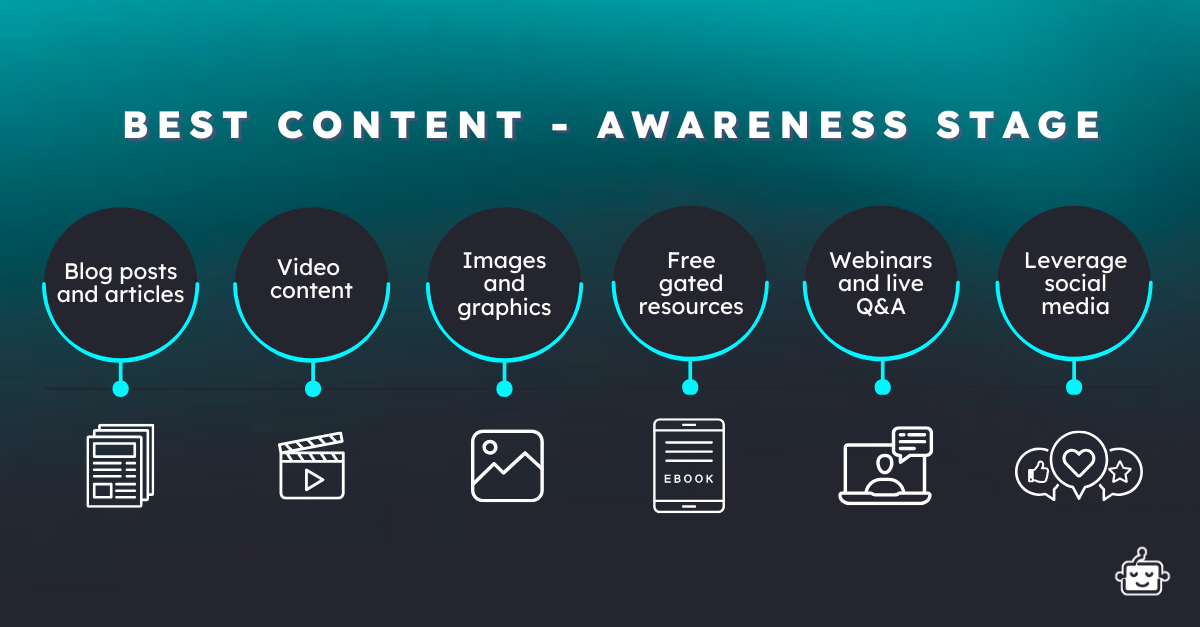
1. Blog posts and educational articles
✅ Why they work: Blog posts are one of the most effective awareness-stage content types because they address the audience’s initial questions without pushing a solution. They focus on explaining problems, trends, or concepts in a way that’s easy to understand, positioning your brand as a helpful resource. By optimizing for SEO, blog posts also capture organic traffic from buyers actively searching for information.
Key benefits:
- Educates and informs: Blog posts break down complex issues, helping buyers better understand their problem.
- Builds trust: Providing valuable content with no strings attached helps establish credibility and authority.
- Drives organic traffic: SEO optimization ensures your content appears where your audience is looking for answers.
Best practices:
- Focus on specific, problem-focused topics that your audience is likely to search for.
- Use clear, conversational language to make complex ideas accessible.
- Back up claims with data or credible sources to enhance trust.
- Optimize for SEO by including relevant keywords and ensuring a user-friendly structure.
2. Videos and explainer content
✅ Why they work: Videos simplify complex concepts and engage audiences visually, making them a highly effective medium for the awareness stage. Short explainer videos can help your audience understand their problem and its context without overwhelming them. They’re particularly effective on platforms like YouTube or social media, where audiences consume quick, engaging content.
Key benefits:
- Grabs attention quickly: Videos are a visually engaging way to stand out in crowded digital spaces.
- Enhances understanding: Dynamic visuals make it easier to explain and clarify challenging topics.
- Multi-platform appeal: Videos perform well across social media, websites, and email campaigns.
Best practices:
- Keep videos short (under 1 minute ideally) to maintain audience attention.
- Focus on addressing the problem, not promoting a solution, to build trust.
- Use captions to improve accessibility and engagement.
- Invest in quality production to ensure clear visuals and sound.
3. Infographics and visual storytelling
✅ Why they work: Infographics transform complex data and ideas into visually digestible formats. They’re perfect for summarizing statistics, breaking down processes, or explaining trends, making them a go-to choice for busy audiences. Infographics are also highly shareable, which helps extend your reach across platforms.
Key benefits:
- Simplifies complexity: Infographics distill detailed information into easy-to-understand visuals.
- Increases engagement: Visual content grabs attention and holds it longer than text-heavy formats.
- Boosts shareability: Infographics are often shared on social media and across networks, increasing brand visibility.
Best practices:
- Focus on a single idea or set of data to avoid overwhelming the audience.
- Use clean, high-quality visuals and clear headings for maximum impact.
- Include your brand logo subtly to ensure recognition without appearing overly promotional.
- Ensure it’s mobile-friendly, as many users will view infographics on their phones.
4. Free resources (eBooks, guides, and checklists)
✅ Why they work: Free resources like eBooks and checklists provide immediate value, helping your audience better understand their problem and take small steps toward solving it. These resources demonstrate your expertise and build trust while giving buyers something tangible to engage with.
Key benefits:
- Provides value upfront: Free resources help your audience feel supported, not sold to.
- Establishes expertise: High-quality guides and checklists position your brand as an authority.
- Encourages lead generation: Gated resources can help capture contact information for follow-up.
Best practices:
- Tailor resources to address a specific problem or challenge faced by your audience.
- Make them actionable, offering practical steps or tools your audience can use.
- Avoid overly promotional language; keep the tone helpful and educational.
- Ensure the design is clean and professional for maximum credibility.
5. Webinars and live Q&A sessions
✅ Why they work: Webinars and live Q&A sessions allow you to connect with your audience in real time, offering valuable insights into challenges and industry trends. They position your brand as approachable and knowledgeable, which is critical at the awareness stage, and help you capture leads that you can nurture afterwards.
Key benefits:
- Deepens engagement: Real-time interaction builds trust and allows for personalized responses.
- Showcases expertise: Webinars give you a platform to demonstrate authority in your field.
- Encourages two-way communication: Live Q&As let your audience ask questions and feel heard.
Best practices:
- Choose topics that address broad challenges your audience is likely experiencing.
- Keep presentations concise and focus on delivering actionable insights.
- Use professional tools for seamless hosting and ensure strong internet connectivity.
- Record sessions for reuse as on-demand content for future leads.
6. Social media posts and stories
✅ Why they work: Social media content meets your audience where they already are. Posts, reels, or stories offer bite-sized insights that spark curiosity and drive engagement. They’re particularly effective for building awareness quickly and subtly introducing your brand.
Key benefits:
- Expands reach: Social media platforms expose your content to a broader audience.
- Increases engagement: Short, snappy posts encourage likes, shares, and comments.
- Drives traffic: Links and CTAs in your posts can guide audiences to deeper resources.
Best practices:
- Keep the tone conversational and relatable; avoid sounding overly formal or salesy.
- Use visuals and captions to enhance post performance.
- Incorporate hashtags and trends relevant to your audience for broader reach.
- Regularly analyze metrics to optimize future content.
How does Pathmonk engage and convert visitors in the awareness stage?
Pathmonk’s AI-powered personalization technology plays a critical role in engaging visitors during the awareness stage by providing educational and value-driven content tailored to their initial exploration of a problem or challenge. At this stage, prospects are seeking information, not solutions, and Pathmonk ensures they receive relevant, non-intrusive guidance that builds trust and encourages deeper engagement.
Here’s how Pathmonk works during the awareness stage:
1. Behavioral tracking and analysis
Pathmonk’s AI monitors visitor behavior on your website in real time, observing the types of content they interact with, what pages they linger on, and the navigation paths they take. By analyzing these behaviors, Pathmonk identifies visitors in the awareness stage and tailors content to their needs.
2. Automatically personalized micro-experiences
Pathmonk delivers experiences that align with the visitor’s intent, offering helpful and educational interactions rather than sales-driven content. During the awareness stage, these micro-experiences focus on guiding the visitor toward a deeper understanding of their problem.
For example, in an automotive company website, a visitor exploring an article about “How to Choose the Right Tires for Your Car” might be shown a guide like “Top Tips for Maintaining Tire Longevity.” This keeps the visitor engaged, positions your brand as a knowledgeable resource, and allow the brand to acquire a high-intent lead.
3. Guiding discovery and reducing confusion
Visitors in the awareness stage often feel unsure about where to start or how to structure their research. Pathmonk’s AI helps guide their journey by surfacing relevant, bite-sized content based on their behavior.
4. Real-time adaptation
Pathmonk’s AI adjusts content dynamically based on changes in visitor behavior. If someone who starts by reading a general article shifts to more specific content, Pathmonk seamlessly updates the experiences it offers to provide additional depth.
5. Building trust with educational content
Visitors in the awareness stage are seeking trustworthy, objective information. Pathmonk ensures that the content presented feels educational and supportive, positioning your brand as a credible resource.
Pathmonk’s AI ensures visitors in the awareness stage feel guided and supported, creating a positive first impression of your brand. By offering personalized, relevant content that aligns with their initial exploration, Pathmonk builds trust and lays the foundation for stronger engagement as they progress through the buyer’s journey.
Increase e-commerce sales with personalized experiences
Turn your e-commerce visitors into loyal customers with AI-powered personalization.
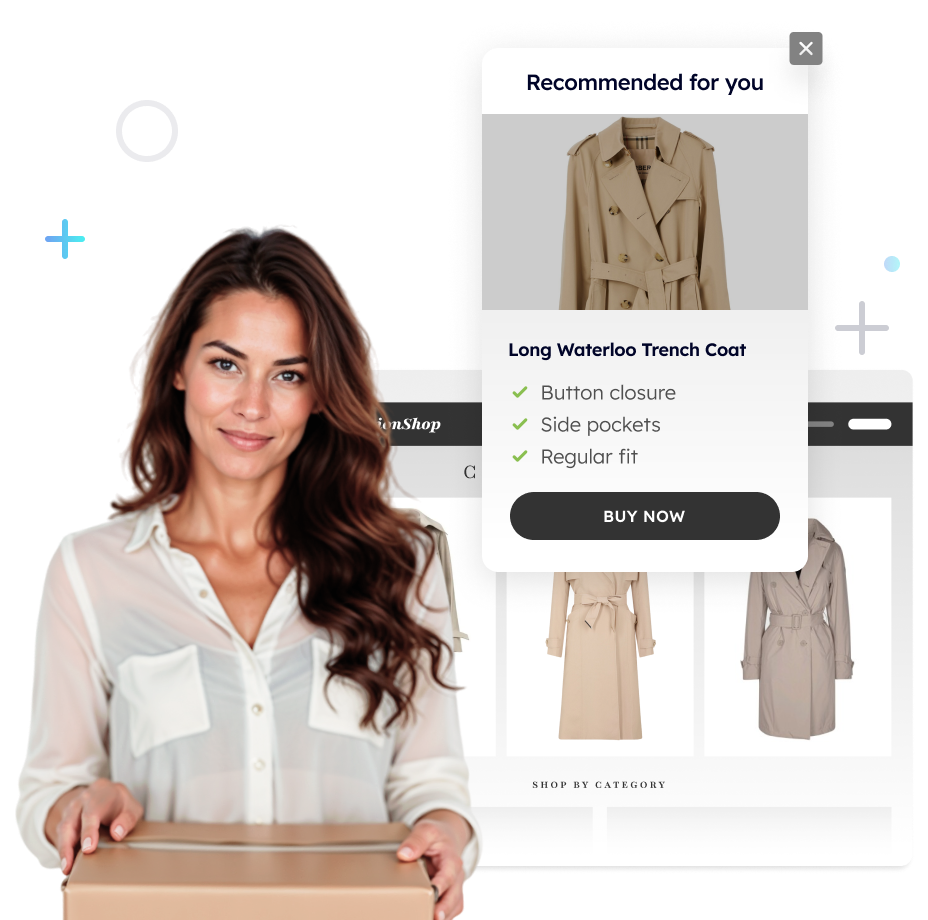
Fast hacks to help you succeed in the awareness stage
If you’re running short of time and need ideas to improve the performance of the awareness stage of your customer journey, there are specific tactics you can implement that will help you improve the visibility and relevance of your content while building trust and authority.
1. Create problem-centric content
People don’t care about your brand until they see how it relates to their lives. At this stage, focusing on the problems your audience experiences—and offering a glimpse of a potential solution—creates a powerful hook.
- Identify your audience’s top challenges and create content that addresses them head-on (e.g., “Why Most Busy Professionals Struggle with Sleep”).
- Use storytelling in your ads to present the problem in an engaging way. For example, start a video with: “You hit snooze three times this morning. Is your mattress holding you back?”
- Pair the content with engaging visuals or short-form videos for platforms like TikTok, Instagram, or YouTube to maximize reach.
2. Leverage partnerships or micro-influencers
Building awareness doesn’t mean going broad in a random way; it’s about being in the right spaces where your audience hangs out. Partnering with brands or influencers with established communities gives you instant access to an engaged, trust-filled audience.
- Partner with micro-influencers (5k–50k followers) in your niche for authentic posts. For example, a sustainable clothing brand could work with eco-conscious creators to showcase “A Day in My Life in Sustainable Fashion.”
- Create co-branded giveaways with complementary businesses to attract a broader audience. For instance, a coffee brand and a productivity app teaming up to offer a “morning productivity kit.”
3. Invest in value-packed, evergreen content
Educational content not only builds awareness but also establishes your brand as a trusted resource. If the content is evergreen, it will continue to attract attention and provide value over time.
- Create shareable guides, checklists, or tutorials that directly address common problems. For example, “The Ultimate Guide to Choosing the Right Mattress for Your Sleep Style.”
- Use infographics or animations to simplify complex topics in visually engaging ways.
- Break down the content into bite-sized pieces for social media—such as tips from the guide or short clips from an educational video. Promote these pieces on all platforms to maximize reach.
4. Run broad, engagement-first ads
At the awareness stage, limiting your reach with hyper-targeting can stifle your potential audience. Instead, run ads that cast a wide net while optimizing for engagement metrics like views, clicks, or reactions. Use content that entertains or informs while capturing attention.
- Create video ads designed to educate or inspire, such as a quick explainer about a problem your audience faces or a fun fact that ties to your industry. For example, “Did you know most people lose 30 minutes of sleep every night due to poor mattress quality?”
- Use broad targeting but optimize for engagement objectives (video views, shares, or reactions) rather than conversions.
- Include a light call-to-action like “Learn more” or “Discover how you can fix this today,” to nudge curiosity without pushing a sale.
How do I measure the success of awareness-stage marketing?
Measuring success in the awareness stage is about tracking how effectively your efforts attract and engage potential buyers. It’s not about pushing for conversions yet—it’s about building visibility, trust, and interest. Here’s what matters most and how to measure it:
- Website traffic
This is the most fundamental metric for the awareness stage. It shows whether your content is driving visitors to your site and how well your promotional strategies are working.
What to track: Unique visitors, page views, traffic sources (organic, paid, social, referral), and the ratio of new vs. returning visitors.
- Content engagement
Engagement metrics show how much value your audience is finding in your content. If visitors are bouncing after just a few seconds or not scrolling past the first 25% of a page, it may mean your content isn’t relevant or engaging enough.
What to track: Time spent on page, scroll depth, video views, video completion rates, social shares, likes, and comments.
- New leads
While the awareness stage isn’t about aggressive lead generation, capturing early interest is a good indicator of how well your content is performing. Gated resources like checklists, beginner’s guides, or webinars can help gather leads without being pushy.
What to track: Number of sign-ups, downloads, or email subscribers generated from awareness-focused CTAs.
- Brand visibility
Awareness is about getting your brand noticed. Visibility metrics show how far your content is spreading and whether your brand is gaining recognition.
What to track: Social media impressions, shares, mentions, backlinks, and rankings for awareness-stage keywords.
- Audience feedback
Listening to your audience gives qualitative insights that metrics alone can’t provide. Comments, reviews, or survey responses highlight what resonates and what doesn’t.
What to track: Comments on blogs or social media, feedback from gated content, and surveys asking visitors what they found most helpful.
What are some common mistakes in the awareness stage?
The awareness stage is a critical point in the buyer’s journey where potential customers are trying to still understand what their problem is, and what approaches they could follow to solve it.
It’s a phase that requires businesses to offer informational content that educates buyers and builds trust.
However, many businesses make common mistakes that can inadvertently push buyers away. Let’s explore these mistakes in detail and understand how they can be avoided.
1. Pushing sales too early
One of the biggest mistakes in the awareness stage is introducing sales pitches before the audience is ready. Jumping straight to solutions can easily alienate your audience. At this stage, buyers are still trying to understand their problem—they’re asking “What’s wrong?” or “Why is this happening?” They’re not ready to explore potential fixes, let alone compare products or services. By skipping over the critical step of helping them define and understand their issue, solution-focused content risks feeling irrelevant or overwhelming.
Why this is problematic:
- It disconnects from the buyer’s mindset: Awareness-stage buyers are curious and cautious. If your content is too focused on promoting solutions, they may feel misunderstood or pressured.
- It can make your brand seem self-serving: Solution-driven content at this stage may come across as a hard sell, eroding trust before you’ve had the chance to build it.
- It misses the opportunity to educate: By focusing on solutions too early, you neglect the chance to position your brand as a helpful resource that understands the problem from the buyer’s perspective.
How to avoid it:
- Focus on the “why” and “what”: Create content that explores the causes and implications of the problem. For example, instead of writing “Why Our Software Is the Best for Inventory Management,” write “5 Common Inventory Management Challenges That Impact Efficiency.”
- Answer audience questions: Research what your audience is asking in forums, social media, or search engines. Address these questions with detailed, non-promotional content.
- Use storytelling to connect: Share relatable scenarios that reflect your audience’s struggles, such as “How One Business Reduced Lost Sales by Identifying Inventory Gaps.” This creates empathy and shows that you understand their pain points.
- Highlight industry knowledge: Focus on educating your audience with trends, statistics, or insights relevant to their problem. Position your brand as a trusted expert rather than a salesperson.
2. Ignoring audience pain points
Failing to address your audience’s specific challenges or concerns is one of the quickest ways to make your content irrelevant. Buyers in the awareness stage are actively looking for content that resonates with their situation and helps them make sense of their problem. When your content doesn’t reflect their struggles, it can feel impersonal and generic, driving prospects to competitors who speak directly to their needs.
Why this is problematic:
- It fails to connect emotionally: Buyers want to feel understood, especially in the early stages of their journey. If your content doesn’t acknowledge their pain points, they may not see your brand as relatable or trustworthy.
- It reduces engagement: Generic content is forgettable. Buyers are less likely to click, share, or explore further if they don’t see their concerns mirrored in your messaging.
- It limits your credibility: Addressing pain points demonstrates that you understand your audience and their industry. Ignoring them can make your brand seem out of touch or less authoritative.
How to avoid it:
- Research your audience deeply: Use surveys, customer reviews, forums, and social media to uncover common challenges and frustrations. Look for patterns in what your target audience is asking or complaining about.
- Map out buyer personas: Create detailed profiles of your ideal customers, including their goals, challenges, and pain points. Use these personas to guide your content creation.
- Write problem-centric content: Instead of focusing on solutions or product features, address the root challenges your audience faces. For instance, a financial planning service might create articles like “Why Saving for Retirement Feels Overwhelming—and How to Start” rather than “The Best Retirement Plan Services in 2024.”
3. Neglecting SEO optimization
In the awareness stage, buyers turn to search engines to explore their problems and gather basic information. If your content isn’t optimized for the keywords and phrases they’re searching for, it’s unlikely to show up in their results. No matter how insightful or helpful your content may be, neglecting SEO means it could remain invisible to the very audience it’s meant to serve.
Why this is problematic:
- Your audience won’t find you: Awareness-stage buyers rely heavily on search engines to answer questions like “Why does my air conditioner stop cooling?” or “What causes low back pain?” If your content doesn’t appear in search results, they’re likely finding your competitors instead.
- It wastes effort: High-quality content that isn’t optimized for search engines fails to reach its full potential. You miss opportunities to engage your audience and drive organic traffic to your site.
- It reduces brand visibility: Poor SEO prevents your brand from appearing in searches, making it harder to establish awareness and recognition in your industry.
How to avoid it:
- Conduct thorough keyword research: Use tools like Google Keyword Planner, SEMrush, or Ahrefs to identify awareness-stage keywords. Focus on phrases like “how to,” “why does,” or “what causes.” For example, a pest control company could target keywords like “how to prevent ants in the kitchen” or “what attracts termites to your home.”
- Optimize on-page elements: Include primary keywords in your title tags, meta descriptions, headers, and body text. Ensure your URLs are concise and contain relevant keywords.
- Structure content for readability: Use clear headings, bullet points, and short paragraphs to make your content scannable and user-friendly. Search engines prioritize well-structured content that offers a good user experience.
- Incorporate internal and external links: Internal links guide readers to more of your content, keeping them engaged on your site. External links to reputable sources enhance your credibility and SEO ranking.
4. Using jargon and technical terms your audience may not know
Awareness-stage buyers are typically unfamiliar with the nuances of your industry or the specialized language associated with it. If your content is filled with jargon, acronyms, or overly technical terms, it can confuse or alienate your audience, making them feel overwhelmed rather than informed.
Why this is problematic:
- It creates a barrier to understanding: Complex language makes it harder for buyers to grasp the key points of your content, leading to disengagement.
- It makes your brand seem unapproachable: Jargon can make your content feel like it’s written for insiders rather than beginners, potentially intimidating buyers who are just starting their journey.
- It reduces trust: If buyers can’t easily understand your content, they may assume your brand doesn’t value clear communication or isn’t focused on their needs.
How to avoid it:
- Simplify your language: Use clear, straightforward language that resonates with a broad audience. Replace jargon with terms that are easy to understand, and explain any technical concepts you need to include. For example, instead of “utilizing machine learning algorithms to enhance customer segmentation,” say “using AI to better understand your customers.”
- Define technical terms: If specialized language is necessary, provide simple definitions or examples to help readers follow along. For instance, “A CRM, or customer relationship management tool, helps you manage interactions with your customers.”
- Write as if you’re explaining to a beginner: Imagine your audience is encountering the topic for the first time. Frame your content around answering their basic questions without assuming prior knowledge.
- Test your content for clarity: Have someone outside your industry review your content to ensure it’s accessible and easy to understand.
5. Relying too much on paid ads
While paid ads can drive quick visibility, relying heavily on them during the awareness stage can backfire. Buyers in this phase are curious and cautious—they’re researching, not ready to make decisions. Ads that come across as overly promotional or sales-driven may be ignored, skipped, or even create a negative impression. Additionally, paid ads alone don’t foster the long-term engagement and trust that organic content can provide.
Why this is problematic:
- It limits trust-building: Paid ads often feel transactional, focusing on clicks rather than creating a deeper connection with the audience. Buyers may view them as less credible compared to organic content.
- It’s expensive and unsustainable: Overreliance on ads means you’re constantly spending to maintain visibility. Without a solid base of organic content, your awareness efforts stop as soon as the ad spend ends.
- It misses educational opportunities: Awareness-stage buyers need informative, problem-focused content. Ads rarely provide the depth or context they’re seeking at this stage.
How to avoid it:
- Balance paid and organic efforts: Use paid ads to supplement, not replace, organic content. For example, run ads promoting blog posts, guides, or infographics rather than directly pitching products or services.
- Focus ad content on education: Create ads that direct buyers to educational resources rather than product pages. For instance, promote a video explaining “How to Choose the Right Solar Panels” instead of an ad for “The Best Solar Panels on the Market.”
Free competitor
analysis template
Understand your competitors, spot opportunities, and stay ahead in your market.
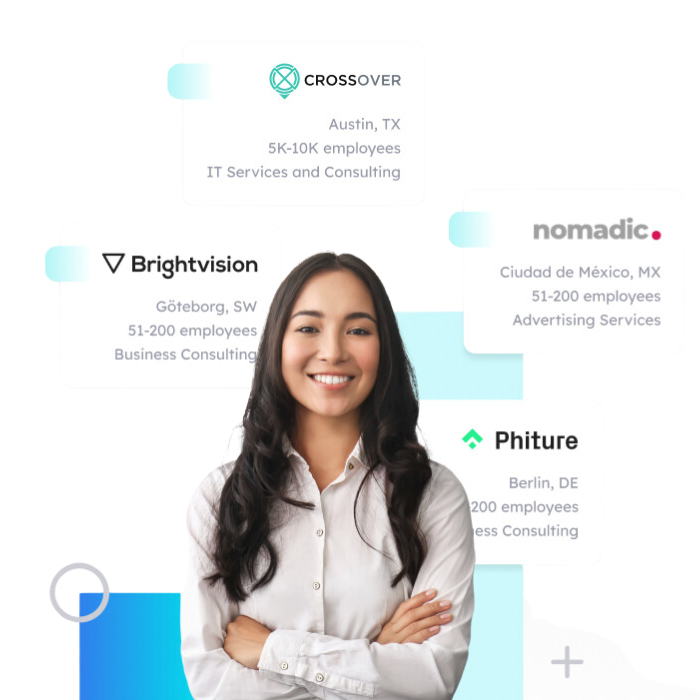
Frequently Asked Questions about the consideration stage
What are the 5 stages of awareness?
The 5 stages of awareness, introduced by Eugene Schwartz, is a powerful framework to understand a prospect’s journey from being oblivious to a problem to becoming ready to purchase. It’s a nuanced way to tailor marketing messages based on the prospect’s emotional and psychological readiness, going beyond the broad strokes of the traditional buyer’s journey.
This framework differs from the awareness stage in the customer journey. While the awareness stage broadly addresses recognizing a problem, the 5 stages of awareness delve deeper into the mindset and readiness of the prospect, enabling highly tailored messaging at every step.
In the Unaware stage, prospects don’t even realize they have a problem. It’s not that the problem doesn’t exist—it simply hasn’t entered their awareness. Marketing here focuses on grabbing attention and sparking curiosity, often through storytelling or emotional appeals. For example, a campaign highlighting the importance of sleep for productivity might help someone realize their sleep is subpar without even mentioning mattresses yet.
Once they recognize an issue, they move into the Problem aware stage. At this point, they know something’s wrong but don’t yet know what solutions exist. This is your chance to educate them about the problem and its impact on their lives. Content like “5 Signs Your Mattress is Wrecking Your Sleep” encourages introspection and builds urgency to seek a fix.
In the Solution aware stage, they’ve begun exploring ways to solve their problem. They know products or services exist but haven’t encountered your brand—or don’t know why your solution is better. Here, it’s all about showcasing how your offering is unique and fits their needs. This might involve highlighting your product’s key benefits compared to competitors or sharing testimonials that build credibility.
When prospects enter the Product aware stage, they’re aware of your product and likely comparing it with alternatives. They need reassurance that your solution is the best fit. At this point, trust-building becomes critical through customer success stories, in-depth demos, or guarantees that eliminate risk.
Finally, in the Most aware stage, they’re ready to buy but may need a final nudge. The goal here is to make the purchase decision easy by addressing lingering doubts or creating urgency, such as offering limited-time discounts or free trials.
What should your awareness stage ads do
Awareness stage ads are designed to introduce your brand, product, or service to people who are unfamiliar with it. The primary goal is not to sell but to capture attention, spark curiosity, and educate. These ads should focus on connecting with your audience on an emotional or informational level, addressing their pain points or introducing a relevant topic they care about.
Here’s what your awareness stage ads should achieve:
1. Grab attention
The first goal of an awareness stage ad is to stand out and stop the scroll. Use compelling visuals, engaging headlines, or emotionally resonant content to draw people in. For instance, an ad for a fitness app might show a relatable image of someone struggling to find time for workouts, paired with a tagline like “When was the last time you worked out for you?”
2. Educate and inform
Since your audience may not be aware of their problem or your solution, awareness stage ads should provide value through education. For example, an ad could explain common issues, highlight trends, or provide surprising statistics that relate to your product or service.
3. Build emotional connection
This is a chance to establish trust and make your brand memorable. Use storytelling or show empathy for your audience’s struggles. For example, if you sell eco-friendly products, your ad might showcase the impact of plastic waste with a message like “Together, we can make a difference—starting today.”
4. Introduce your brand subtly
While the focus isn’t on selling, you should still establish your presence. Make sure your branding is visible and memorable, whether through a logo, tagline, or brand voice. The goal is to leave a lasting impression without coming off as pushy.
5. Encourage engagement or curiosity
Your ads should create a desire to learn more, whether that’s clicking through to a blog post, watching a video, or exploring a free resource. Use calls to action like “Discover more” or “Learn how we can help.”
Optimizing the awareness stage: the bottom line
The awareness stage of the buyer’s journey is something that shouldn’t be overlooked or ignored. The awareness stage is going to be the foundation that affects the way the rest of the stages of the buyer’s journey play out.
This is why extensive research needs to be conducted when establishing the strategies required to make your targeted audience aware of your brand and its products or services. These tactics can help determine the type of content that would be best for making your prospective clients aware of your business. These strategies then need to be integrated into your content creation in order to achieve the goal of generating leads and increasing website conversions.




